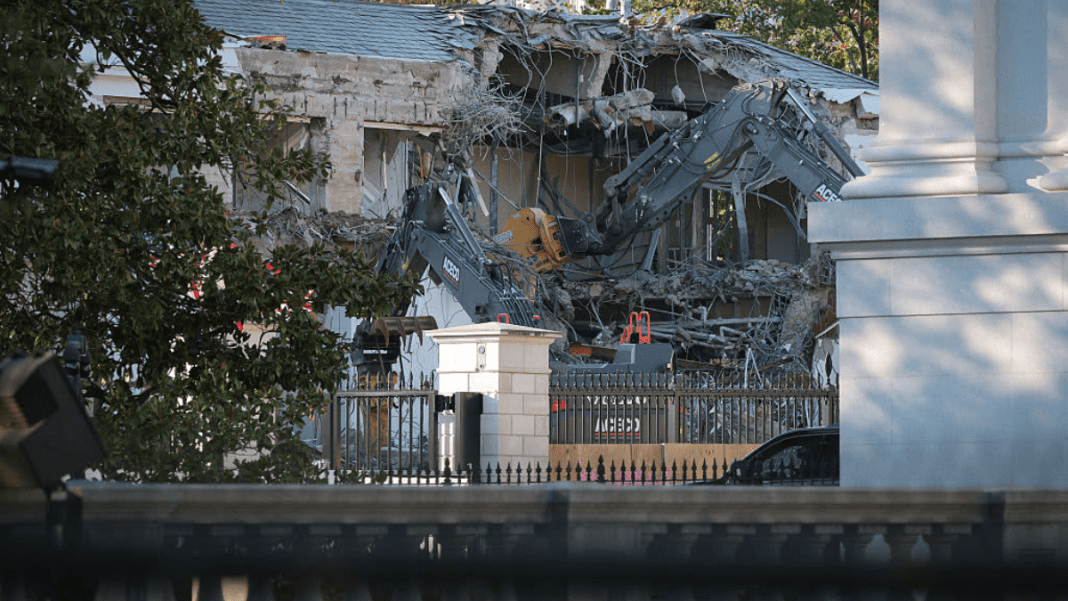The historic White House, one of the most recognizable buildings in the world, has become the center of a major storm. Reports say that the East Wing of the building is being torn down to make space for a huge, luxury ballroom. The new hall, said to cost around $300 million and stretch over 90,000 square feet, is being built as a personal project under the direction of Donald Trump.
The project has drawn massive criticism from preservation experts and historians. Many say the White House is not just a residence but a symbol of America’s history and democracy. For over a century, the East Wing has hosted meetings, press conferences, and tours for visitors from across the nation and the world.
Critics argue that removing parts of such a symbolic space is like cutting a page from a history book. The sound of bulldozers and the sight of wrecking crews in a place that once hosted presidents, first ladies, and dignitaries from around the globe have left many people stunned.
Archaeologist Matthew Vincent’s Furious Reaction
Matthew Vincent, an American archaeologist and program director at the American Center of Research (ACOR) in Jordan, has spoken out in anger. Often compared to the fictional hero Indiana Jones, Vincent has spent decades saving ancient artifacts and monuments from destruction by extremists and looters. He says he is horrified to see something similar happening at home.
Political battle ignites — Obama backs Newsom in war over Trump’s Prop 50 redistricting
He compared the demolition to the acts of cultural destruction once carried out by ISIS in Iraq and Syria. Those extremists destroyed ancient temples, statues, and cities, erasing priceless pieces of world history. Vincent said the same spirit of disregard for heritage is visible in this White House project.
“The White House doesn’t belong to one person,” he said in disbelief. “It’s a public building owned by the American people. Destroying it without public consent or oversight is unthinkable.” He added that this kind of act sends a dangerous message — that leaders can erase the past simply because they don’t like it.
Vincent also noted that in many countries, cultural vandalism begins with ideology. Groups or leaders destroy monuments and heritage sites to rewrite history and glorify their own image. He said that replacing historic rooms with extravagant features like a ballroom is “two sides of the same coin” as what extremists did abroad — both are attempts to shape history through destruction.
Outrage and Calls for Accountability
Preservationists in Washington, D.C., say the demolition violates the city’s planning laws. Normally, any change to a historic building must go through multiple reviews. But the White House project seems to have moved forward without those steps. Critics call it a clear bypass of regulations meant to protect the nation’s landmarks.
Inside the capital, the move has sparked debates about power, oversight, and respect for the nation’s shared history. Many say it’s another sign of growing disregard for checks and balances in government.
Vincent said that this kind of action is not just about buildings — it’s about identity. “When you tear down a space like the East Wing, you tear away a part of who we are as a people,” he said. He pointed out that the same attitude was seen earlier when the famous Rose Garden was changed into a private-style terrace, erasing an iconic public space.
He urged citizens to speak up against what he described as “authoritarian-style destruction.” “People should be demanding accountability,” he said. “This isn’t how a democracy treats its history.”
The administration has downplayed the criticism. White House Press Secretary Karoline Leavitt described the project as a “routine upgrade,” calling the outrage exaggerated. But experts say that removing historically important structures under the cover of “upgrades” is a serious threat to heritage preservation.
The controversy continues to grow as more images of the demolition spread online. Citizens, historians, and cultural organizations are demanding explanations and calling for an immediate halt to the project.
For now, the sound of demolition equipment echoing through the White House grounds stands as a powerful symbol of a much larger debate — one that pits personal ambition against the protection of a nation’s shared memory.





